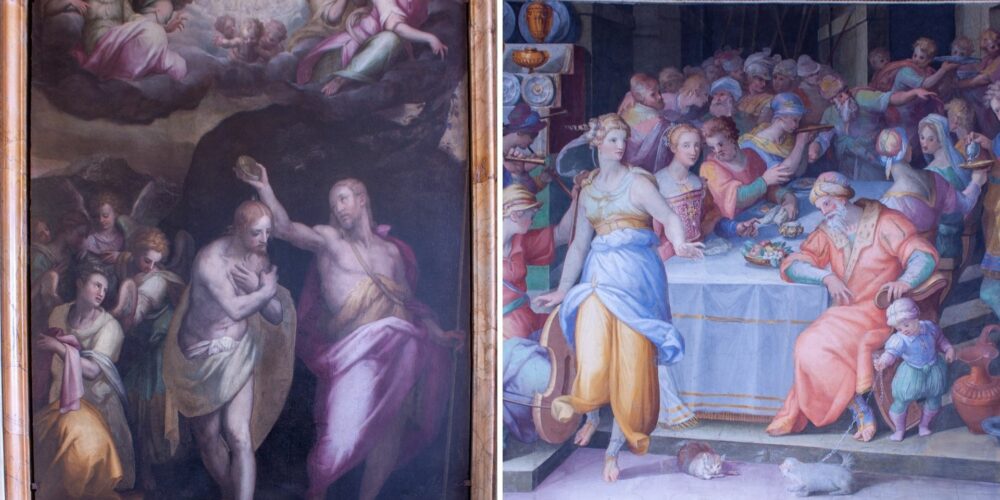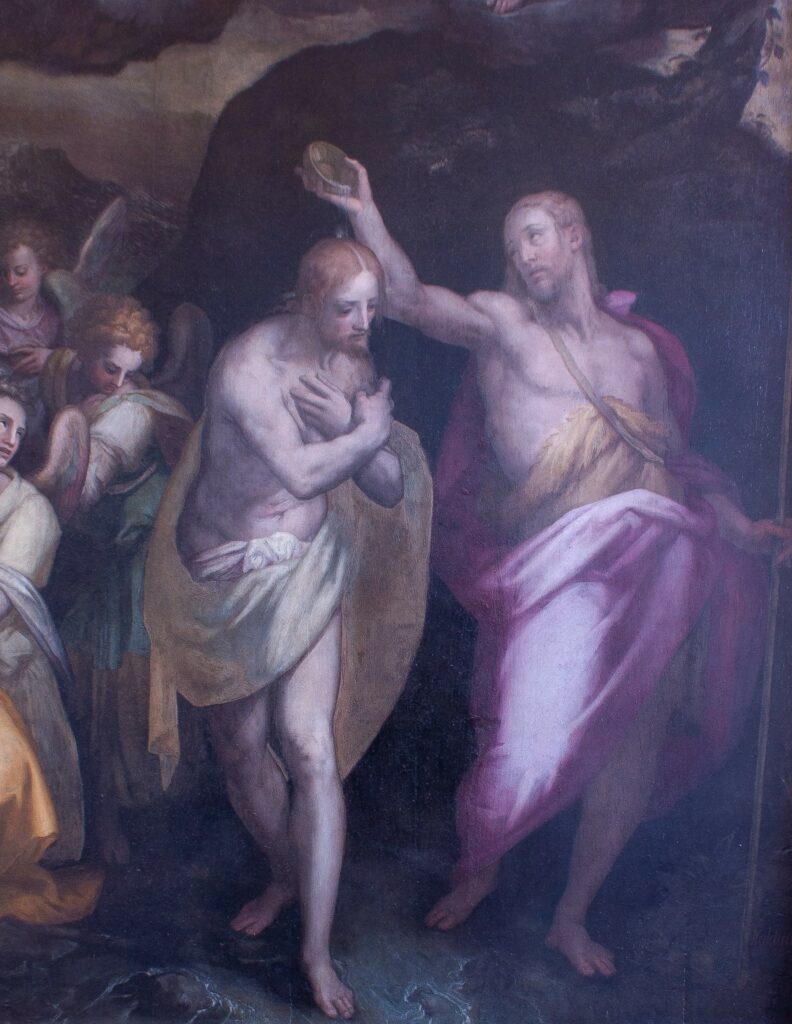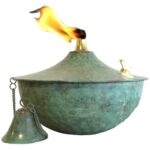Welcome to the heart of the nave of this church of Trinità dei Monti. Feel free to sit down comfortably on the benches in front of you.



Here you are in front of the Chapel of Saint John the Baptist, named after the cycle of frescoes, dedicated to that Saint. It was decorated at the command of Giovanni Battista Altoviti, who wanted a chapel in honour of his patron Saint.
The Chapel of Saint John the Baptist is one of the last to have been constructed at Trinità dei Monti. It was added at the same time as the Borghese Chapel opposite it, at the final phase of the building of the church, in 1570.
In 1573, the banker, Giovanni Battista Altoviti acquired the patronage of the chapel and dedicated it to his patron Saint, who is also the patron of his hometown, Florence. On either side of the altar, one finds two coats of arms in marble which show a wolf rampant, the arms of the Altoviti family. Around 1580, Giovanni Battista Naldini executed the frescoes, focusing on the life of John the Baptist.
The fact that the chapel is situated at the entrance to the church underlines the mission of the precursor John the Baptist, who led humanity to Jesus. Besides, baptism is the sacrament by which each person enters the Church. To know more about baptism, click on the description of the altarpiece.

The painting over the altar (the ‘altarpiece’) represents the Baptism of Jesus. One can easily recognize John the Baptist on the right, clothed in an animal skin, and Christ in the centre of the picture, over whom John the Baptist pours the water of baptism, taken from the Jordan River which flows at their feet. They are surrounded by angels present in the scene holding the clothes of Jesus.
In the upper part of the picture, one can see heaven open, where a multitude of angels surround the Holy Spirit, who, in the form of a Dove, illuminates the scene and radiates light.
But what does this baptism mean?
John the Baptist is the cousin of Jesus, he is the first to administer a baptism of repentance, which corresponds to a “baptism of conversion for the forgiveness of sins” (Gospel of Mark 1: 4). Being Jewish, John the Baptist speaks principally to other Jews, baptizing them so that they may be purified from their sins.
In this way, he also baptizes Jesus (who is a Jew) with the water of the Jordan. At that moment, heaven opens, and God recognizes him as his Son, through a voice that comes from heaven: This is the scene represented in this picture before you. Jesus can now begin his public life, his mission on earth.
Once he is baptized, Jesus goes to baptize too, not with the water of the Jordan but with the Holy Spirit. Christian baptism is a baptism accomplished interiorly by the Holy Spirit, that is, by an action of God himself. By baptism, a person enters the great family of Christians.
The theme of the baptism of Jesus is drawn from the Gospels, especially that of Mark 1: 2-11:
‘Now John was clothed with camel’s hair, and had a leather girdle around his waist, and ate locusts and wild honey. He proclaimed: “After me comes he who is mightier than I, the thong of whose sandals I am not worthy to stoop down and untie. I have baptized you with water; but he will baptize you with the Holy Spirit.”
In those days Jesus came from Nazareth of Galilee and was baptized by John in the Jordan. And when he came up out of the water, immediately,
he saw the heavens opened and the Spirit descending upon him like a dove; and a voice came from heaven, “You are my beloved Son; with you I am well pleased.”’ (Mark 1: 6-11)

On the left wall is represented the martyrdom of Saint John the Baptist, divided into two scenes. This martyrdom, which inspired many artists, is recounted in the Gospel of Matthew (14: 1-11) :
“At that time, Herod the tetrarch, heard about the fame of Jesus and he said to his servants, ‘This is John the Baptist; he has been raised from the dead; that is why these powers are at work in him.’ For Herod had seized John and bound him and put him in prison […] And though Herod wanted to put him to death, he feared the people, because they held him to be a prophet. But when Herod’s birthday came, the daughter of Herodias danced before the company, and pleased Herod, so that he promised with an oath to give her whatever she might ask. Prompted by her mother, she said, ‘Give me the head of John the Baptist here on a platter.’ And the king was sorry; but because of his oaths and his guests he commanded it to be given; he sent and had John beheaded in the prison; and his head was brought on a platter to the girl, and she brought it to her mother …”
Description of the picture :
On either side of the altarpiece, two prophets of the Old Testament are represented: Isaiah and Zechariah.
On the right, the prophet Isaiah is surmounted by an inscription:
« Vox clamantis in deserto : parate viam domini restas facite semitas eius » (A voice crying in the desert, prepare the way of the Lord, make straight his paths).
This citation is taken from the Gospel of Mark 1:3. The evangelist refers to the words of the prophet Isaiah who in the seventh century BC announced the coming of John the Baptist, the precursor of Christ, sent to prepare his way.
On the left, Zechariah is accompanied by an inscription that indicates:
« Tu puer, propheta altissimi vocaberis, praebis ante faciem Domini parare vias eius » (and you little child shall be called prophet of the Most-High, for you will walk before the face of the Lord, to prepare his ways) (Luke 1: 76)
This quotation comes from the Gospel of Luke and was pronounced by the father of Saint John the Baptist, also called Zechariah. There is a confusion here between Zechariah the prophet and Zechariah the father of John the Baptist.
The two monochrome rectangles under the prophets were painted by a student of Naldini, Giovanni Balducci. That on the left represents the martyrdom of Isaiah, who according to tradition, was cut in two by order of Manasseh because he announced the punishment of Israel. The other unfortunately is not visible.
He was a pupil of Pontormo, then of Vasari, raised and trained in Florence. He made a decisive journey to Rome in 1560, where he studied assiduously the ancient sculptures as well as the works of the great masters of the Roman Renaissance, such as Michelangelo and Raphael. His career then took a decisive turn, and he went back to Florence, where he was propelled into the highest realm of the artistic scene in Florence. He received numerous commissions and participated in workshops of great importance, such as those employed in decorating the apartments of Francis I at Palazzo Vecchio. It was during a trip to Rome between 1577 and 1580 that he painted the cycle of frescoes of the life of Saint John the Baptist at Trinità-dei-Monti. He died in Florence in 1591, where he is interred in the church of Saint Michele Visdomini.
Giovanni Antonio Dosio began his career as an architect and sculptor in Rome, where he had been trained. He then established himself in Florence where he received numerous prestigious commissions, before being called to Naples for different works now considered his masterpieces, notably the Certosa of San Martino. He is the one who designed the chapel of Saint John the Baptist, as well as the splendid decoration in stucco of the vault and of the altar.

Whether believers or unbelievers, we suggest you now take a short time of silence.
In the image of Jesus who accepts to be baptized by John the Baptist, we invite you also to agree to receive what the people around you can give you. Let’s agree to rely on others and not carry everything ourselves. Let us be accompanied with confidence and abandonment, let us be helped and supported. This attitude, which is not the most obvious at first glance, allows us to demonstrate the friendship and love that we have for those close to us.
We invite you to listen to this song: